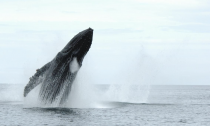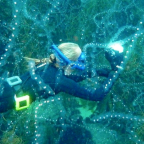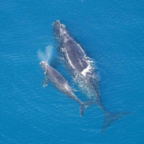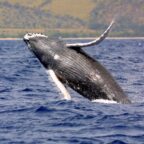
Whale enthusiasts are celebrating the return of the humpback to B.C.’s coastal waters, even though it means people need to learn how to coexist with the gentle giants. The Northeast Pacific population of humpback whales, which spend much of their time in B.C. waters during the summer months, has experienced a remarkable recovery in the past few decades.
The migratory whales, known for their underwater ballads, are easily recognizable by their long pectoral fins and knobby heads.
They had been hunted to near extinction by the mid 1900s but there are now more than 20,000 humpbacks in B.C. waters, according to the Department of Fisheries and Oceans.
“We’ve never seen so many humpbacks in inshore waters,” said Paul Cottrell, DFO marine mammals co-ordinator.
“It’s been incredible these past few years.”
In the waters northeast of Vancouver Island, whale researcher Jackie Hildering counted seven humpbacks in 2004. Last year, she counted 91.
But the whales’ return to inshore waters could put both them and people in danger. The humpbacks, listed as a species of special concern, now frequent fishing hot spots, shipping lanes, and busy harbours in B.C., where they are more likely to run into nets or collide with boats.
Humans can be seriously injured if their boat hits a humpback whale, which can weigh as much as 30 tonnes and grow to 16 metres long.
Boaters who collide with humpbacks often come away with broken bones. One kayaker had to receive jaw reconstruction surgery, and several people have become paraplegic after encounters with humpbacks.
On the other hand, humpback whales have died from vessel strikes. They can also drown or starve to death if they get entangled in fishing gear.
Through the DFO marine mammal hotline, Cottrell was called to 18 entanglements in 2017, all with humpbacks. Without human intervention, the whales could drown or starve. Cottrell has rescued nine whales so far this year.
But many whales likely die from entanglement without authorities ever knowing, said Hildering, a researcher with the Marine Education and Research Society.
The ones that survive bear scars from their ordeal.
One in every two humpbacks spotted by humans have scars from run-ins with fishing gear or boats, said Hildering.
Unlike their fellow baleen-whale cousins, the grey whales, humpbacks don’t seem to mind spending much of their time close to harbours and boat traffic, she explained.
And while humpbacks are generally slow swimmers, they do not travel in straight lines and do not surface frequently to breathe — only once every 20 minutes or so. This makes it difficult for scientists to find the whales and tricky for vessels to avoid them, said Hildering.
B.C. boaters may need a reminder nowadays to watch out for the recently-returned humpback whales, but the whales used to be commonplace.
In the early 1900s, humpbacks were so plentiful in B.C. waters that they inspired the first commercial whale-watching venture in the world, according to Jason Colby, an environmental historian at the University of Victoria.
The Vancouver company took upper-middle class residents to Howe Sound with the promise they would see the mysterious sea giants, said Colby. But hunting whales for their blubber was also common practice at the time and soon, humpbacks, along with other whales in the area, were seen as lucrative resources instead of tourist attractions.
“Its an interesting early clash between the extractive values that shaped this coast and an early glimpse of the values that will emerge,” said Colby, referring to the idea that whales should be protected, rather than hunted.
In 1965, a whaling ban allowed the humpback populations to slowly recover in the North Pacific. British Columbia and Alaska waters are important foraging grounds for humpbacks that travel north from Mexico and Hawaii every year. The whales from Hawaii have done especially well in recent years, said Cottrell.
It’s a success story not only for scientists but for whale watching businesses as well, said Hildering.
“What an incredible positive story in terms of conservation but also for coastal British Columbians,” she said.
“Now in the same areas you can see orcas, you have this other incredible marine ambassador.”
Authorities are now focused on minimizing the amount of conflict between whales, the fishing industry and recreational boaters.
In July, the federal government enacted legislation that bans boaters from travelling within 100 metres of a whale. For orcas, that zone expands to 200 metres. Whale advocate and Vancouver Island resident Peter Hamilton wants B.C.’s humpbacks to receive the same protection as orcas.
Some boaters don’t take the new rules seriously enough, said Hamilton, who patrols the waters near Comox, B.C., everyday.
“We’ve been able to stop a lot of boats that are basically on top of the whales,” he said.
Hildering said it is difficult to define what a safe distance is when it comes to humpback whales and that it is best to give them wide berth. Baleen whales don’t have the bio sonar capabilities of toothed whales like orcas and need more room to navigate, she explained.
Observers are applauding efforts to help people live side-by-side with the whales and say the story of B.C.’s humpback whales could serve as a shining example for other conservation efforts.
“The return of humpbacks shows us that nature can heal,” said Colby.
“Nature can restore itself if we give it room to breathe, if we stop doing damage.”
People who see a whale in distress can call the DFO marine mammal hotline at 1-800-465-4336.















Social Profiles